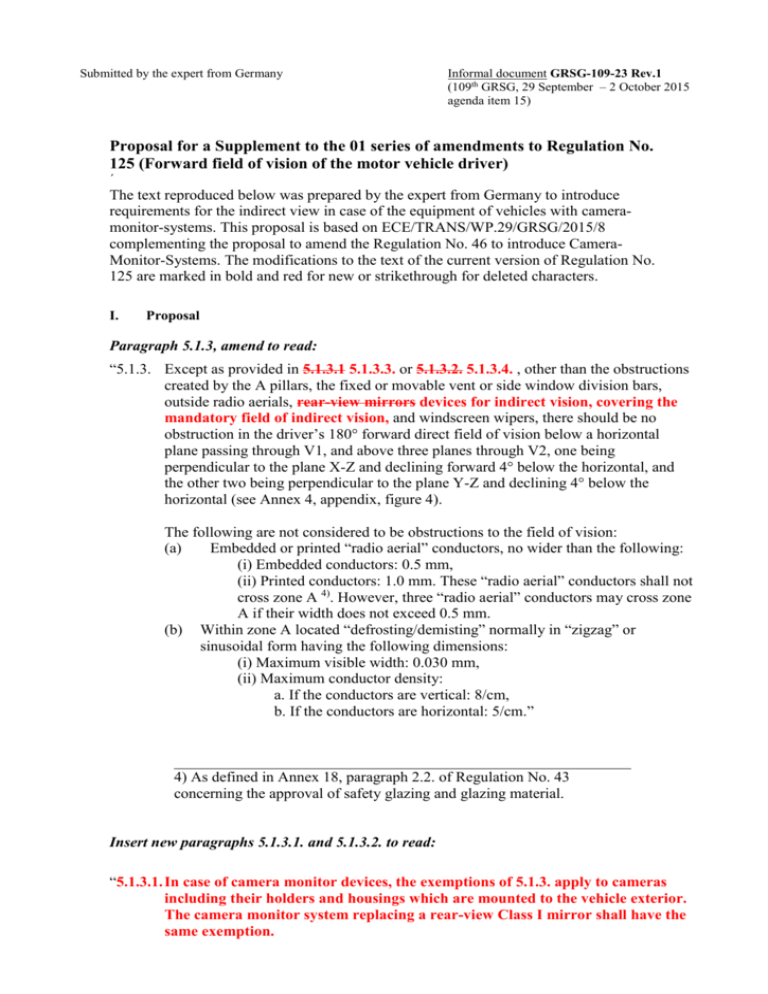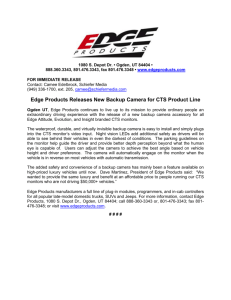CMS - unece
advertisement

Submitted by the expert from Germany Informal document GRSG-109-23 Rev.1 (109th GRSG, 29 September – 2 October 2015 agenda item 15) Proposal for a Supplement to the 01 series of amendments to Regulation No. 125 (Forward field of vision of the motor vehicle driver) ´ The text reproduced below was prepared by the expert from Germany to introduce requirements for the indirect view in case of the equipment of vehicles with cameramonitor-systems. This proposal is based on ECE/TRANS/WP.29/GRSG/2015/8 complementing the proposal to amend the Regulation No. 46 to introduce CameraMonitor-Systems. The modifications to the text of the current version of Regulation No. 125 are marked in bold and red for new or strikethrough for deleted characters. I. Proposal Paragraph 5.1.3, amend to read: “5.1.3. Except as provided in 5.1.3.1 5.1.3.3. or 5.1.3.2. 5.1.3.4. , other than the obstructions created by the A pillars, the fixed or movable vent or side window division bars, outside radio aerials, rear-view mirrors devices for indirect vision, covering the mandatory field of indirect vision, and windscreen wipers, there should be no obstruction in the driver’s 180° forward direct field of vision below a horizontal plane passing through V1, and above three planes through V2, one being perpendicular to the plane X-Z and declining forward 4° below the horizontal, and the other two being perpendicular to the plane Y-Z and declining 4° below the horizontal (see Annex 4, appendix, figure 4). The following are not considered to be obstructions to the field of vision: (a) Embedded or printed “radio aerial” conductors, no wider than the following: (i) Embedded conductors: 0.5 mm, (ii) Printed conductors: 1.0 mm. These “radio aerial” conductors shall not cross zone A 4). However, three “radio aerial” conductors may cross zone A if their width does not exceed 0.5 mm. (b) Within zone A located “defrosting/demisting” normally in “zigzag” or sinusoidal form having the following dimensions: (i) Maximum visible width: 0.030 mm, (ii) Maximum conductor density: a. If the conductors are vertical: 8/cm, b. If the conductors are horizontal: 5/cm.” 4) As defined in Annex 18, paragraph 2.2. of Regulation No. 43 concerning the approval of safety glazing and glazing material. Insert new paragraphs 5.1.3.1. and 5.1.3.2. to read: “5.1.3.1. In case of camera monitor devices, the exemptions of 5.1.3. apply to cameras including their holders and housings which are mounted to the vehicle exterior. The camera monitor system replacing a rear-view Class I mirror shall have the same exemption. 5.1.3.2. For vehicles which are equipped as standard with approved rear-view mirrors, that are optionally replaced by camera-monitor-devices, the exemptions of 5.1.3. apply also to monitors, provided: (a) their obstruction of the direct view does not exceed the level of obstruction of the corresponding exterior rear-view-mirror including its housing and holder and (b) the position of the monitor is as close as practicable to the position of the rear-view mirror it replaces. Footnote to para. 5.1.3.2.: see GRSG report ECE/TRANS/WP.29/GRSG/88, para. Xx concerning the period of application of this paragraph.” GRSG report: xx. GRSG intended to promote the introduction of camera-monitor systems (CMS) in vehicles of category M1 also by allowing for a temporary period an obstruction in the direct field of view of the driver by the installation of a monitor in place of a mirror. GRSG planned to remove this temporary exemption such that the Contracting Parties shall not be obliged to accept approvals based on paragraph 5.1.3.2. of Regulation No. 125 as from 1 September 2021. Renumber the former paragraphs 5.1.3.1. and 5.1.3.2. accordingly. II. Justification In applying the same provisions as for mirrors the exemptions for obstructions due to camera monitor devices shall be added to the Regulation no. 125 as cameras and their holders and housings are mounted to the vehicle exterior. To promote and to support the installation of camera monitor devices on vehicles of category M1, the possibility of obstructions due to monitors should be allowed for a transitional period of 5 years after entry into force of the provisions for camera monitor devices in Regulation no. 46. According to the proposal this is only valid for vehicles that are type approved with conventional mirrors and where these mirrors are replaced by camera monitor devices. The allowed level of obstruction shall not exceed the level of obstruction of the corresponding mirror that is replaced by the camera monitor device and the position of the monitors shall be close to the position of the mirrors they are replacing. 2 __________ 3






